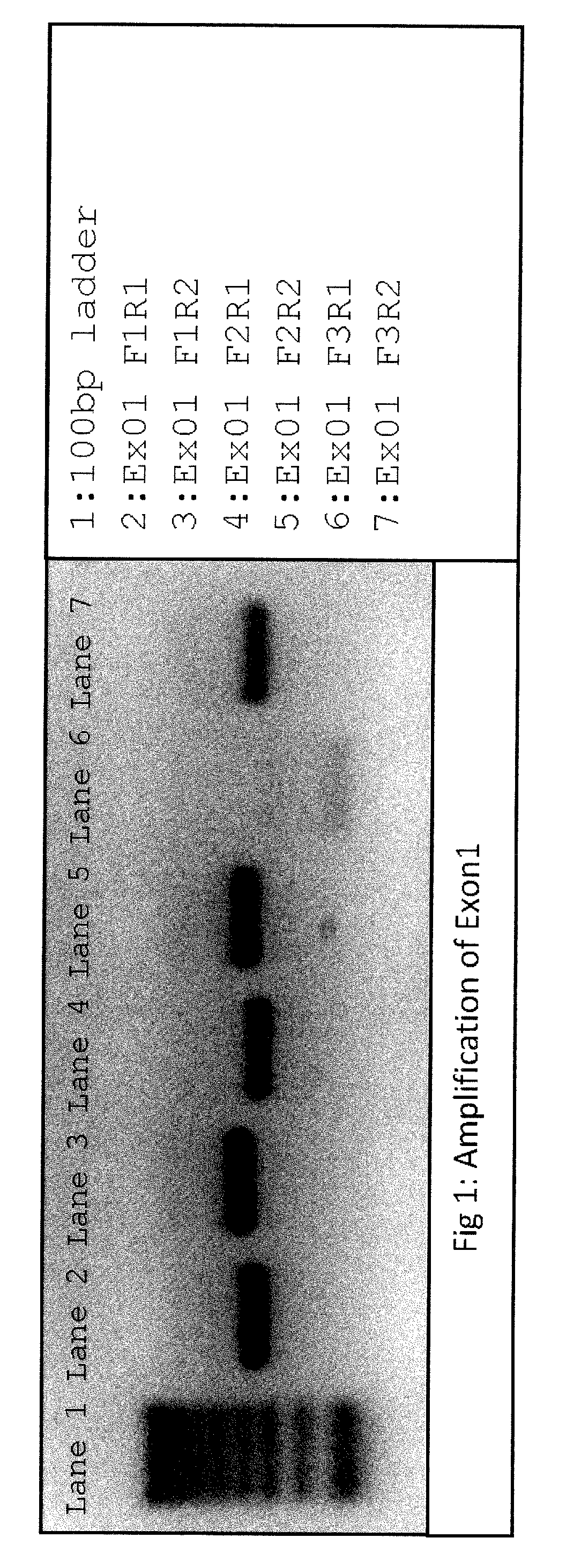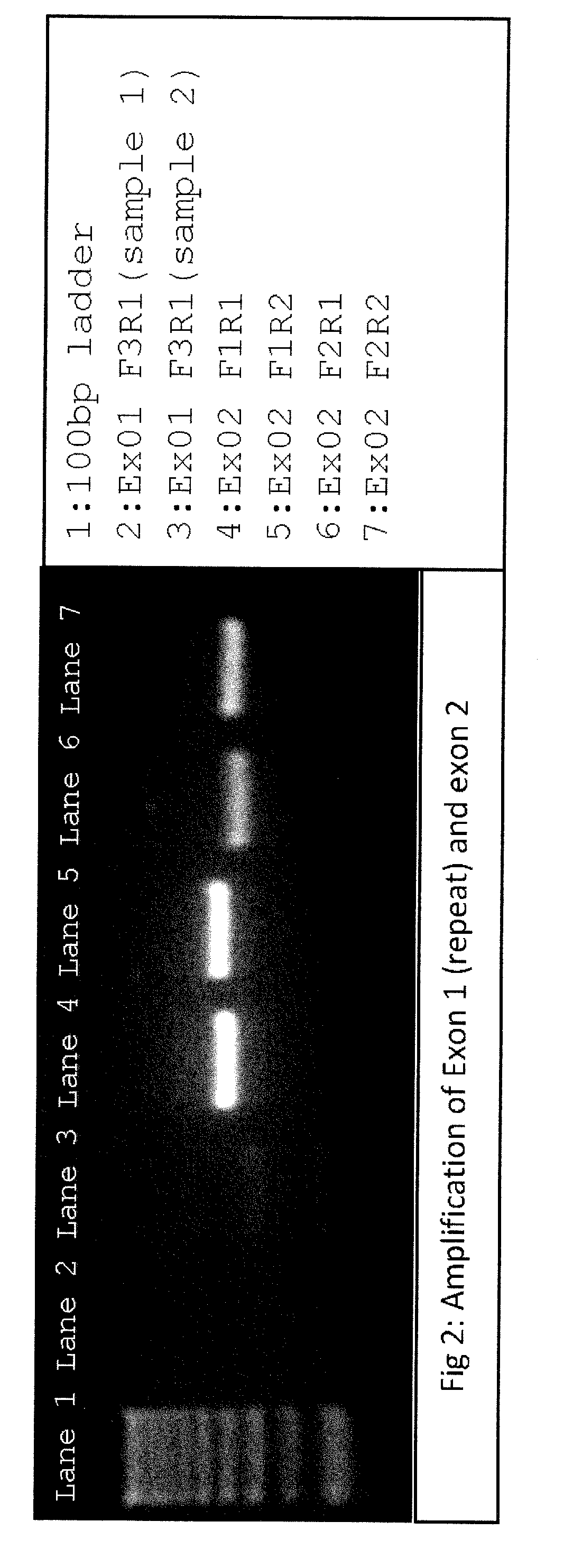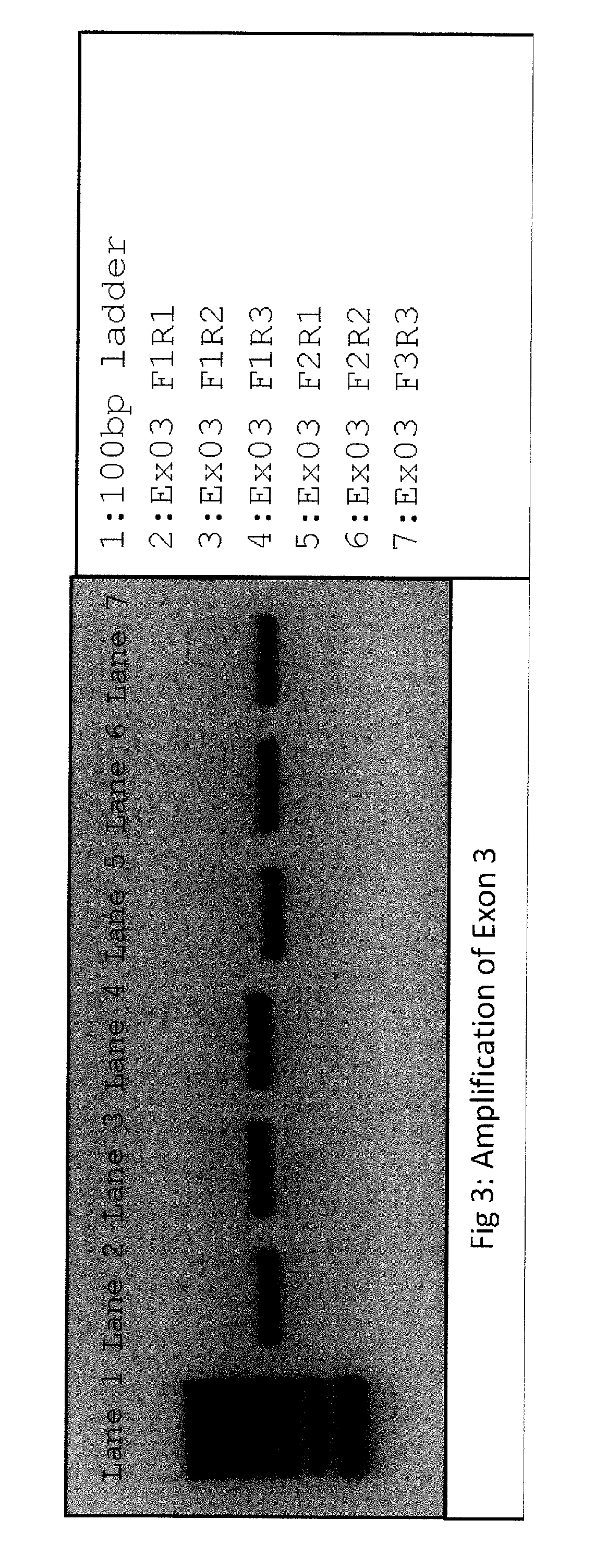Consensus-based allele detection
a consensus-based allele and detection technology, applied in the field of next-generation sequencing-based detection of alleles, can solve the problems of loss of specificity in the use of primers that bind to consensus sequences, and achieve the effect of facilitating primer design
- Summary
- Abstract
- Description
- Claims
- Application Information
AI Technical Summary
Benefits of technology
Problems solved by technology
Method used
Image
Examples
example 1
tion of Homologous Loci Using Consensus Sequence-Specific Primers
[0172]Primers suitable for next generation sequencing (NGS) and specific for consensus sequence between RHD and RHCE genes were designed for exons 1 through 5, and tested for correct product amplifications of both genes using different primer combinations, both in uniplex and in multiplex reactions. Amplifications were tested in eight different samples, including rare Rh blood group types:
TABLE 1Blood type of samplesSampleBlood typeSample 1RHD+, Cw typeSample 2RHD+, CcEeSample 3wDt3, CceSample 4RHD*DIIIa-hetSample 5Ce, RHD+Sample 6DAR-hemSample 7r'sSample 8Ce, RHD+
[0173]All primers consisted of a NGS tag portion in their 5′ end and a sequence-specific portion. In this example, used tags were:[0174]for forward primers: ACACTCTTTCCCTACACGACGCTCTTCCGATCT (SEQ ID NO: 1)[0175]for reverse primers: GTGACTGGAGTTCAGACGTGTGCTCTTCCGATCT (SEQ ID NO: 2)
[0176]Consensus Sequence-Specific Portions were:
SEQ ID NO:RH Exon 1Forward prime...
example 2
ation of Amplified Products from Example 1
[0179]This example shows that amplification products using different primer combinations shown in example 1 correspond indeed to both genes (RHD and RHCE). In other words, homologous regions of both genes were amplified at the same time by the consensus sequence-specific primers.
[0180]Amplification products were purified and Sanger sequenced in an ABI PRISM® 3730XL Genetic Analyzer according to standard procedures. Samples had been fully characterized previously for their Rh blood group phenotype and genotype. Thus, for each exon, discriminating positions between both genes were successfully identified. Table 2 shows said positions for two samples (genotypes DDCCee and ddccee). If both genes had been amplified by the same primer set, electropherograms for said samples should show double peaks (heterozygotes) at said positions (FIGS. 6-15).
TABLE 2Polymorphic positionsDiscriminatingBases to beExonGenotypepositiondetected1DDCCee48G, CddcceeG2DD...
example 3
Analysis of RHD / RHCE Sequencing Reads
[0182]Simulated sequence reads from theoretical exon sequences of the RHD and RHCE genes that would be generated by the above presented primers were created using ART (art_Illumina Q version). Illumina pair-end reads were created with the following parameters: length=200 nucleotides, coverage=40 reads, mean fragment size=230 nucleotides, mean size deviation=10. Default settings were used for insertion and deletion rates: first-read insertion rate=0.00009, deletion rate=0.00011, second-read insertion rate=0.00015, second-read deletion rate=0.00023. Files were generated in the standard raw data format of NGS technologies (.fastq format) that included quality values for each pair-end read created.
[0183]Sequences were aligned to the RHD gene (RefSeq Gene NG_007494.1; SEQ ID NO: 25) and RHCE (RefSeq Gene NGG_009208.2; SEQ ID NO: 26), the latter bearing mutations corresponding to a ce haplotype. Alignment was performed using Burrows-Wheeler Aligner sof...
PUM
| Property | Measurement | Unit |
|---|---|---|
| Fraction | aaaaa | aaaaa |
| Fraction | aaaaa | aaaaa |
| Fraction | aaaaa | aaaaa |
Abstract
Description
Claims
Application Information
 Login to View More
Login to View More - R&D
- Intellectual Property
- Life Sciences
- Materials
- Tech Scout
- Unparalleled Data Quality
- Higher Quality Content
- 60% Fewer Hallucinations
Browse by: Latest US Patents, China's latest patents, Technical Efficacy Thesaurus, Application Domain, Technology Topic, Popular Technical Reports.
© 2025 PatSnap. All rights reserved.Legal|Privacy policy|Modern Slavery Act Transparency Statement|Sitemap|About US| Contact US: help@patsnap.com



